Hunker Down, Height Up – April Update: University of Missouri Turf Pathology
Weather
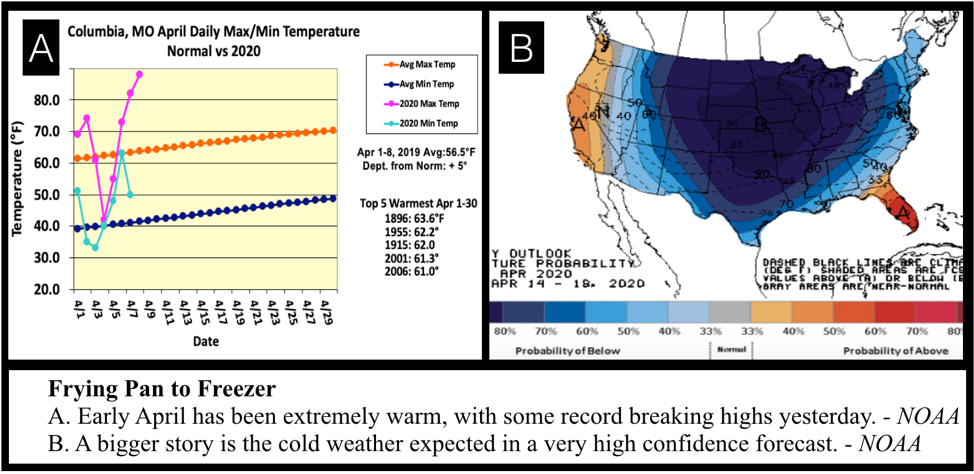
March came and went somehow very slowly, and quickly at the same time. Temperatures for most in the region were 3-5+ degrees above normal, sending spring plant growth into a quick flurry. Forsythias, daffodil, and redbud blooms bursted quickly, our obvious phenological signs to get the preemergents out. Now in early April, growing degree days are well ahead of schedule with base 32 and 50 GDDs ahead of a much cooler 2019 spring by 227 and 77, respectively as of April 7 (thank you to the gddtracker.net service for this great info). As shown in the above graph, early April has followed suit thus far, with yesterday in Columbia, MO at 88 F. This breaks the record high for the date by two degrees, along with several other cities in mid MO. This trend, however, is set to change…
The big weather story over the next week will be the abrupt and severe cold snap set to hit the region. A 50+ degree change is expected over a 24-hour period (!), and most will have freezing temperatures tonight in a cold snap expected to last well into mid-April. Missouri state climatologist Patrick Guinan termed the forecast “impressive long-term cold with high confidence”, and in the last 10 years of writing these updates that dark a shade of blue on the NOAA forecast graphic has rarely if ever graced the screen.
Expect spring to therefore come to a screeching halt, which for us in the short grass growing business may be a good thing during these times. Application windows for preventive herbicide and fungicide applications should extend significantly into the later part of April. Crabgrass seedlings may get burned off. Dollar spot, fairy ring, and other fungal diseases will get muted somewhat after the recent temperature spike to bolt overwintering pathogen populations.
“What about warm-season grasses that have broke dormancy?” In some areas, they may hunker down and retreat back into a dormant state. At this point though, forecasted temperatures alone should not be low enough (low 20s and teens normally needed) to create a large-scale winterkill event, unless on sites that are also chronically wet and shaded (see last year). Taller plants may have a problem, however. Some farmers have planted corn, and the seed is subject to structural damage and death from imbibing cold water. Fruit growers, particularly grape, apple, and peach that are in various stages of bloom due to the warm weather, could also face an extreme loss of yield in this hazardous cold weather shift. Homeowners and gardeners should get used to covering plants.
March also continued the persistent precipitation pattern, with the state over 2.5”+ above normal for the month, accounting for the 7th wettest March on record. This trend dates back well into last year, with 11 of the last 14 months having above normal precipitation. This has sparked a significant flood risk again for the Missouri and Mississippi river basin. After a significant potential rainfall event over this Easter weekend, drier conditions are expected to continue into mid- April, which would be fortunate if the pattern persists.
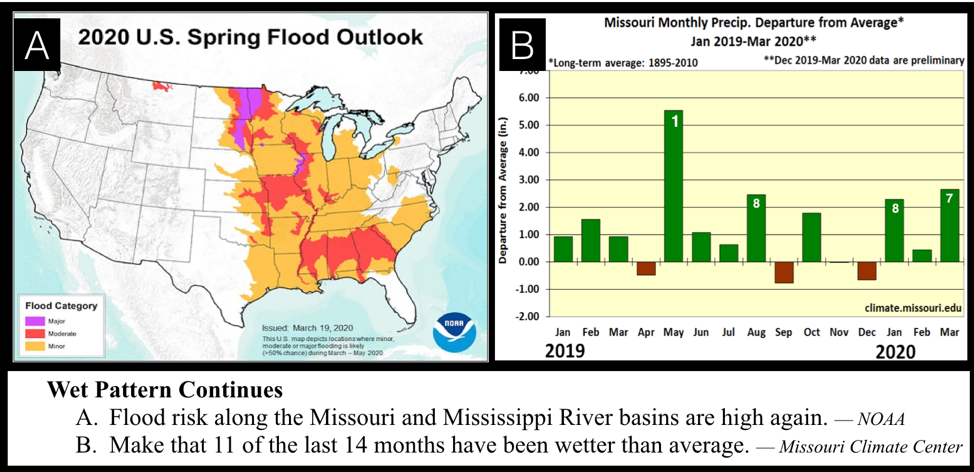
Quick Hits
- COVID-19 Limitations & Resources: Like most of you, we are conducting limited maintenance and conducting only the essential activities at the research farm. After all, the grass is still growing and we are continuing to plan and execute our field research in a much different manner. However, along with campus the turfgrass diagnostic laboratory (aka “me”) is currently closed. My microscopes are locked away and there is not a feasible way to acquire samples under EPA/APHIS guidelines at another location. The MU Plant Diagnostic Clinic as a whole is also closed as we conduct a search for the lead diagnostician, which is being delayed in the current situation. The nematode lab is also currently closed for analyzing and quantifying turfgrass nematode populations. 2020…
- We want to still be a resource for you if you need us, even if it’s from a cold basement office. I can be reached via email at turfpath@missouri.edu at any time, and many of you have my cell phone number. Yesterday, our MU extension team also conducted our first weekly public Q&A “Town Hall” for Home Horticulture on Wednesdays from 11 am – noon. Several MU regional extension specialists, myself, and other MU faculty members organize and contribute to the meeting, which starts with timely updates, but also more importantly delves into your current pressing questions. To register for the Home Horticulture meeting and submit a question, go to https://ipm.missouri.edu/TownHalls.
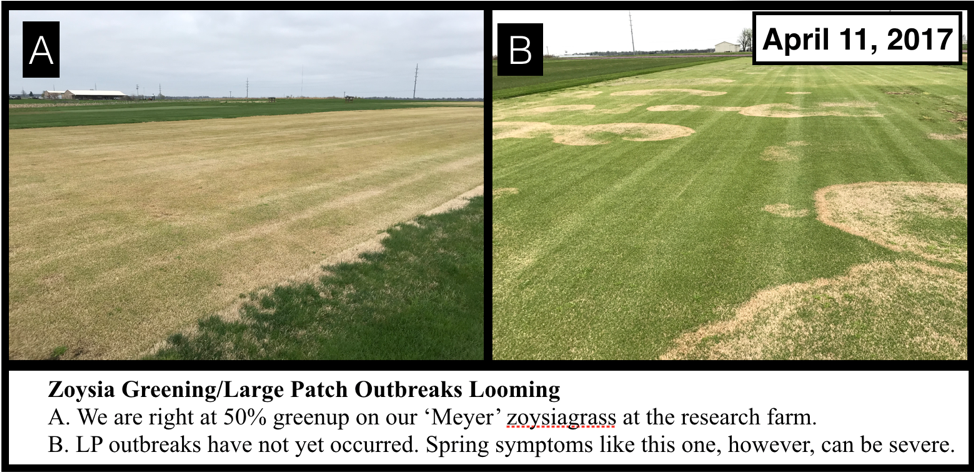
- Large Patch – While the incoming cooler weather may put the brakes on for a bit, preventive spring applications for large patch should be planned now if not very soon on zoysiagrass with a history of the disease. At the turf research farm, we are at about 50% greenup and many are well ahead of that in the region. Large patch symptoms normally start striking in earnest about 10-14 days after full greenup, so preventive applications for the building background pathogen population are now necessary. Previous research has shown better results with a single spring application made early (around 50-55F soil temperature) than later in the spring (65 F soil temperature) or the previous fall. For zoysia lawns with both a history of this disease and where only one application may be allowed, this is the time to apply. Residential labeled, effective fungicides include the QoI fungicides such as azoxystrobin (Heritage), some SDHI fungicides such as flutolanil (ProStar), and some DMI fungicides such as triticonazole (Trinity).
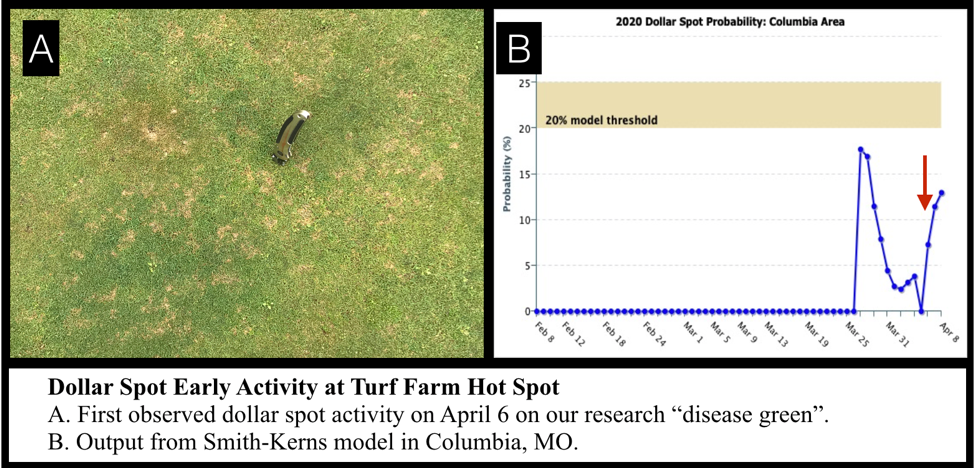
- Earlier this week on our creeping bentgrass “disease” green, we had a few small outbreaks of active dollar spot. No other reports have come in of activity and it should be stated that if anyone were going to get the disease first, it should be us. We inoculate this green annually, and have plots that are left untreated and much maligned in the name of science. The Smith- Kerns model which indicates favorable environmental conditions had a distinct spike near the threshold in late March and was on its way back up when our activity was observed. A few questions have come in regarding the first preventive dollar spot application. Our outbreak is a good indication the app should definitely be down in Springfield and southern MO, and we are close if not there in mid Missouri, St Louis, and Kansas City. Remember that a preventive, watered-in fairy ring application of tebuconazole or triadimefon will also give an added kick of dollar spot prevention, and after this cool spell breaks the time will be right. Sports field managers with susceptible Kentucky bluegrass with past dollar spot symptoms should also consider applying preventively when temperatures rise. To view the Smith-Kerns model output and check your soil temperature for your nearest MO city, go to Threshold Charts.
- Soil Temperature Range: For well, almost everything, in the spring applied preventively, soil temperatures are the key threshold measure. In these reports, the threshold for making a first fairy ring preventive application of a 5-day average in the 55-60 F two-inch soil temperature range has been harped on over and over again (view any previous April report in the Disease Report Index). Fortunately, this range also works well to target various other soilborne and foliar pathogens. Fungicides for large patch take-all patch, Pythium root rot, and dollar spot are also most effectively applied around this important window. This spring like many others, the soil temperature rides along in and out of the range before spiking. With forecasted cold temperatures on the way, soil temperatures will summarily fall. Therefore, if you haven’t made an application yet, plan for the next warm spell to get after controlling many of these troublesome diseases on golf putting greens. Remember that protecting the roots in spring is putting money in the bank to finishing the race with a fruitful fall.
Hunker Down with Heads and Height Up
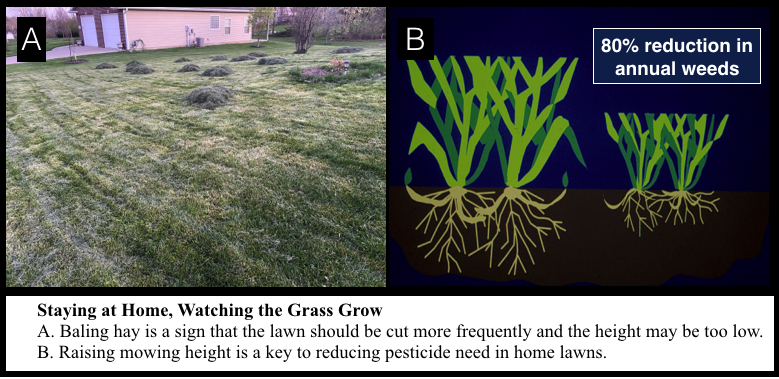
From my standpoint of staying home and hunkering down in my oft cold basement, there are some silver linings. Spending more time with family, (perhaps sometimes too much for their liking), adaptation to different and sometimes uncomfortable methods of working, and more time for introspection on the path of my program, and turfgrass science as a whole, are forced changes that in the long run I believe will be of benefit… character builders if you will. Many in the turfgrass industry are considered essential and working, but these, inconvenient at best, forced changes are impacting us all.
The whir of the lawn mower is heard much more often in my neighborhood than ever before. The pronounced lawn mower engine is a constant companion in my home office. Whether from boredom or the excitement of social distancing and exercising, lawns may be being viewed in the same context as gardens and certainly are being mowed more frequently. This concept is in line with the current spike in sales and lack of supply for gardening materials. Increasing the frequency of cut reduces the potential for scalping and promotes canopy uniformity, and therefore is a common theme of beneficial cultural practices for home lawns. This is a point I try to drive home in extension talks to homeowners, so perhaps this is a brilliant flash of silver…
On the flip side, the family walks around the neighborhood demonstrate the desire for low mowing heights has not changed. The sight of bare soil between sparse, scalped chlorotic leaves is common, along with piles of clippings as shown above. A friend commented that his grass was green, growing and too dense after his fertilizer application and he was taking the height down to reduce the density and perhaps more importantly not have to mow as often. We all know this mindset is exactly the opposite of what needs to be done, as taller tall fescue and Kentucky bluegrass will result in less weed competition and a more extensive root system for the travails of summer.
For lawn care operations, sustainable plant health should be an obvious selling point to a consumer determined to have their lawn look like the fairways at Augusta that I now miss seeing so much. For a homeowner that desires a reduction in synthetic pesticide use or wants an “organic” lawn, a high mowing height for tall fescue or Kentucky bluegrass is required practice. Zoysia can be mowed lower, but it also must be done frequently.
For sports turf and golf course management, also seriously consider mowing height at this time when perhaps resources will be limited later. Will going up 0.25 – 0.5” on sports fields or 0.01 – 0.02” on putting greens earlier this spring increase plant health and allow for continued, and perhaps, necessary reduction of inputs later in a difficult season? The lawn model demonstrates doing so now most likely will, and every text book points to raising mowing heights as a practice to reduce disease and stress, which we all could use now.
Dr. Lee Miller is an associate professor and turfgrass pathologist at the University of Missouri where he routinely provides timely and thorough turf disease updates on the University of Missouri Turfgrass Pathology website. Email him at turfpath@missouri.edu or connect on Twitter!